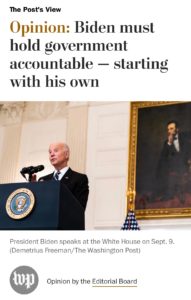The regulatory process should be rebalanced to advance health, safety, justice, democracy and equity values and priorities and to ensure appropriate consideration is given to non-monetary benefits.
- Recommendations for Action on Day One
- Recommendations for Short-term Action (First 100 Days)
- Recommendations for Legislative Action
Recommendations for Action on Day One
- Avoid the false tradeoff between health and the economy.
The next administration should reduce the outsized and harmful role that economic cost-benefit analysis currently plays in the rulemaking process. One important step is for the president and administration officials to avoid using language or adopting policies that reinforce the false premise of a trade-off between protecting the public through new regulations and promoting economic growth. The COVID-19 pandemic underscores both the interconnectedness and complementary nature of public health and a strong economy, and the dangers in presenting them as competing values. The president should direct the director of the Office of Management and Budget to inform agency heads that they should be guided by the following principles and priorities and to develop a new regulatory executive order reflecting these principles:
- Agencies should promulgate regulations as are required by law, are necessary to interpret the law, or are made necessary by compelling public need, such as the need to ensure market rules adequately protect or improve the health and safety of the public, the environment, or the well-being of the American people.
- In deciding whether and how to regulate, agencies should assess statutory requirements; where these requirements designate criteria for regulatory decision-making, they must take precedence over any requirements established by the administration.1
- As agencies consider statutory standards or cost-effective approaches to rulemakings, they must analyze distributive impacts of such approaches and prioritize those approaches that have beneficial effect on equity and those the regulation is intended to benefit.
- Incentives to regulatory entities that include compliance flexibility should only be considered upon certifying that workers and the public are protected to the maximum extent permitted by law.
- Agencies must have plans for strong, consistent and predictable enforcement and compliance.
Recommendations for Short-term Action (First 100 Days)
- Regulatory review executive orders. The administration should issue a new executive order to update Executive Orders 13563 (issued Jan. 18, 2011) and 12866 (issued Sept. 30, 1993) that have guided regulatory review activities. The updated executive order should address more than the regulatory review process:
- Regulatory decisions should be timely and responsive to public need. It takes far too long to complete most rules. Timely action is a benefit to public and business interests. Government must actively assess public needs, identify where regulatory gaps exist, and act to address such gaps. Regulatory decisions should be based on the best available information, balanced with the need to act in a timely manner. Precautionary considerations are an appropriate basis for regulatory action. That is, regulators may appropriately err on the side of caution in assessing scientific and other uncertainties.
- The regulatory process must be transparent and improve public participation. Too many important regulatory decisions are made behind closed doors. Openness, from pre-rulemaking to publication, is essential to meaningful accountability. The Internet age affords new ways of fostering meaningful public participation.
- Regulatory decisions should be based on well informed, flexible decision making. The regulatory process under the Trump administration consists of unprecedented levels of suppressing, altering, and discrediting the information used to support regulatory decisions. There needs to be a premium on placing authority within regulatory agencies to decide what information is critical to effective regulations.
- Authority to make decisions about regulations should reflect the statutory delegation granted by Congress. Federal agencies are given the responsibility to implement legislation and have the substantive expertise necessary to develop effective standards. That expertise should be recognized and provide the foundation for sound regulatory decisions.
- A robust and equity-focused approach to analyzing costs and benefits should be adopted.2
Whether or not the administration determines that it wishes to maintain cost-benefit analysis as a feature of its regulatory decision making, the new executive order should clarify:
- Cost-benefit analyses must properly weight benefits and costs, and not overemphasize costs. No government document or public statement should reference the cost of regulation without raising the benefits derived from such regulation.
- Cost-benefit analyses must take into account co-benefits (benefits from regulatory action distinct from the explicit objective of the action).
- Cost-benefit analyses must include non-monetized considerations such as fairness, distributional equity, community protection, and redressing racial and other historic discriminatory actions.
- Cost-benefit analyses should squarely address where costs and benefits are not precisely quantifiable, including the nature, scope and importance of such non-quantifiable costs and benefits.
- Cost-benefit analyses should include an explicit statement about who benefits and who bears the costs.
- Information and assumptions used in cost-benefit analysis should be transparent and allow for the analysis to be replicated. The analysis should include statements of uncertainty about the assumptions.
Recommendations for Legislative Action
- No judicially imposed cost-benefit analysis.
Congress should adopt legislation clarifying that agency decisions should be made based on criteria stated in their organic statutes and that judicial review should apply the same criteria. Judges should not impose cost-benefit standards where not required by statute.
1 See: https://www.politico.com/news/2020/10/02/trump-white-house-coronavirus-positive-425229ask)
2 Cost-benefit analysis has been required by presidential executive orders, and OMB Circular A-4 (Regulatory Analysis) provides guidance to how agencies are to conduct such analysis. Those developing these recommendations had differing views on the utility of cost-benefit analysis, particularly for social regulations, and could not reach consensus on its use for regulatory decision-making.

